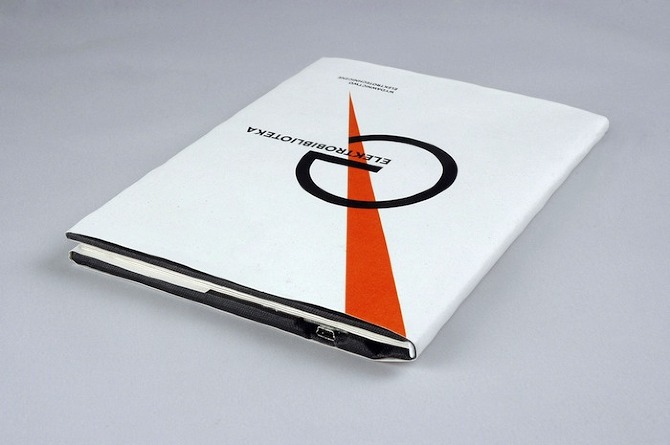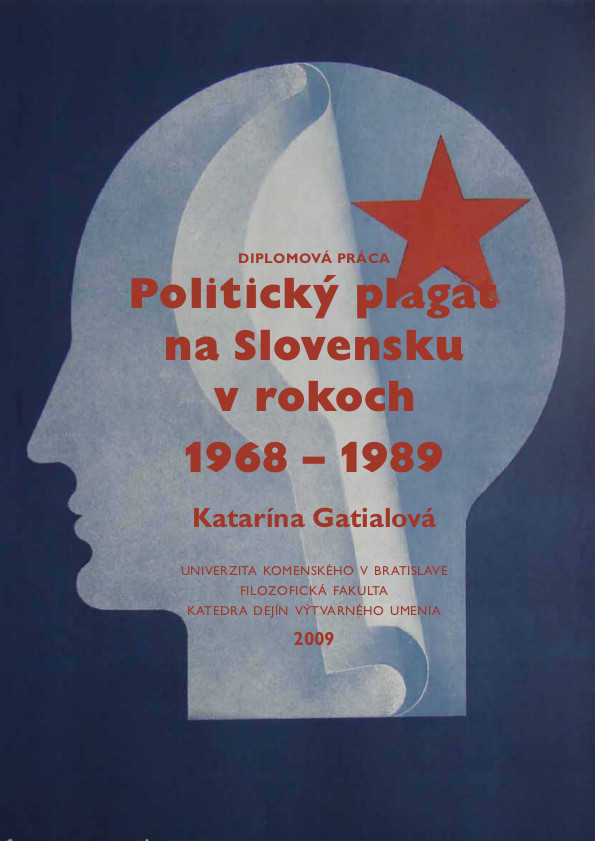Waldek Węgrzyn: Elektrobiblioteka / Electrolibrary (2012)
Filed under augmented book, thesis | Tags: · book, design, e-book, interactive design, interface

A hybrid book project inspired by El Lissitzky’s manifesto published in 1923.
Author: “I was interested in the phenomenon of a book perceived as a kind of interface, which has influenced the way we deal with information. I also wanted to shift the experience typical for print design to the field of digital media. One of the major inspirations was the manifesto ‘The topography of typography’ published in 1923 by a graphic designer El Lissitzky, who has expected a book to be replaced with something he called “electrolibrary”. It seems that his predictions came true.
The final result of the project is the paper book that can be connected to the computer via USB cable. It is able to physically detect which page is currently open and send that information to the Electrolibrary website. By turning pages or touching given illustrations you can navigate through the website and get additional information such as hyperlinks, quotations, movies etc. Of course you can also unplug the cable and read it like a normal book.
The book was intended to be a single object, just for presentation. The great interest in my project that I encounter surprised me. I did not expect that at all, so maybe this project can be developed further.” (source)
Diploma thesis
Multimedia dept, Academy of Fine Arts, Katowice, Poland
Supervisor: Bogdan Król
via Jono van Belle
demonstration video
Lissitzky’s manifesto
View online (HTML) [Polish]
Comment (0)Katarína Gatialová: Politický plagát na Slovensku v rokoch 1968 – 1989 (2009) [Slovak]
Filed under thesis | Tags: · 1960s, 1970s, 1980s, art history, graphic design, ideology, politics, propaganda, slovakia, totalitarianism

“Politický plagát na Slovensku v období 70. a 80. rokov 20. storočia patrí spolu s ďalšími prejavmi oficiálneho umenia k sporným bodom našej kultúrnej histórie. Plagáty, produkované a podporované oficiálnou štátnou politikou, boli jednou z vizuálnych dominánt tejto doby, avšak bez výraznejšieho agitačného vplyvu na väčšinu obyvateľstva. Charakteristické znaky a symbolika angažovanej plagátovej tvorby, ale tiež jej obsahová „vyprázdnenosť“, zrkadlia obdobie svojho vzniku. Plagáty boli exponovanou oficiálnou maskou režimu. Dobová nadprodukcia politických plagátov počas normalizácie spôsobila ich výtvarnú aj obsahovú devalváciu. V súčasnosti sa tento okruh prác dá považovať za definitívne uzavretý, bez autentického pokračovania alebo priameho dosahu na dnešnú výtvarnú tvorbu. Ideologické pozadie politických plagátov však spôsobilo na jednej strane neskorší nezáujem, až odpor voči danej problematike, na druhej strane nejasnosti a skreslenie informácií o tomto druhu tvorby. Dnešná kunsthistória takmer ignoruje angažované plagáty obdobia 70. a 80. rokov. Názor širšej verejnosti závisí do znaènej miery od veku. Predstavitelia staršej generácie, ktorí mali možnosť stretávať sa vo svojom každodennom živote v predprevratovom období s týmito artefaktmi, nedokážu zaujať neutrálne stanovisko a negatívne hodnotia problematiku ako celok. Predstavitelia mladšej generácie, ktorí skúmané obdobie osobne nezažili, prípadne len v ranom detstve, vnímajú tieto diela oficiálnej kultúry nezaťažene a veľmi pozitívne. Dostupné informácie sú však obmedzené, názory mladých ľudí sú preto mnohokrát deformované populárnymi výstupmi na túto tému. Politické plagáty sa spolu s ďalšími prejavmi propagandy a oficiálnej kultúry minulého režimu stali často len akousi zábavnou kuriozitou. Názory na tematiku politických plagátov teda oscilujú medzi dvoma krajnými bodmi – tzv. ostalgickým obdivom a jej radikálnym odsúdením. V tejto diplomovej práci sa pokúsim odpútať sa od oboch vyhranených názorových polôh, mojou snahou bude pozrieť sa na angažované plagáty 70. a 80. rokov 20. storočia bez predsudkov a uvažovať o nich z čo najväčšieho nadhľadu.”
Master thesis
Art History Dept, Faculty of Philosophy, Comenius University in Bratislava, 2009
Supervisor: Alexandra Kusá
159 pages
video lecture (Public Face of Power, Communist Propaganda Posters from Czechoslovakia and Central Europe in the Second Half of the 20th Century) [English]
Comment (0)Florian Hoenig: Computational Aesthetics and Visual Preference: An Experimental Approach (2006)
Filed under thesis | Tags: · aesthetics, complexity, computational aesthetics, computing, information aesthetics, perception, vision
Computational Aesthetics is a term which has been frequently used by scientists interested in quantitative approaches towards the concept of aesthetics during the last century. A review of both past and recent works attempting to quantify aesthetic preference of various stimuli is given, which shows that aesthetics was described as some function of complexity and order in many theories.
Since most measures were hardly relating to knowledge of human perception, complexity is reinterpreted in the context of a currently accepted model of visual perception and a hypothesis is formulated which states that human visual preference is not independent of complexity (cell excitation) at the very first stage of visual processing.
An estimate representative for cell activity in early visual processing is presented: Multivariate Gabor Filter Responses. Additionally, image properties such as aspect ratio, resolution and JPEG compressibility are used to sanity-check any correlations.
The estimate calculated, compared against human preference ratings of photographs, shows statistically significant but low correlations. However, the machine learning experiments performed, fail to predict any better than one would by taking the mean value of the data.
Even though these results only loosely relate to aesthetic perception, it’s motivating further research and closer inspection of image features and their relation to perceptual properties and visual (aesthetic) preference.
Thesis
Computer Science, JKU Linz, Austria
Supervisor Josef Scharinger
118 pages
PDF
View online (Scribd.com)

